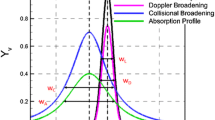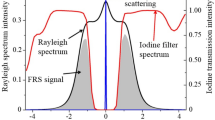Abstract
The mixture fraction variable, ξ, is very useful in describing reaction zone structure in nonpremixed flames. Extinction limits and turbulent mixing are often described as a function of this variable. Experimental evaluation of ξ is critical for improving our understanding of the influence of turbulent mixing on the chemistry process. Heretofore, the evaluation of mixture fraction in combusting flow required multiple simultaneous concentration measurements. In this paper we present a fuel designed to permit measurements of mixture fraction by Rayleigh scattering technique only. A Rayleigh intensity/mixture fraction correspondence has been obtained experimentally in a laminar coflow flame. The influence of strain rate and differential diffusion effects have been investigated using laminar counterflow diffusion flame and shifting equilibrium chemistry models. The results obtained from comparisons between experiments and these models are very encouraging and suggest that the Rayleigh/mixture fraction correspondence established is valid under both the turbulent mixing and laminar strained flamelet combustion regimes.
Similar content being viewed by others
References
Bilger, R. W. 1976: Turbulent diffusion flames. Progress in Energy and Combustion Science. 1, 87–109.
Bilger, R. W. 1976: The structure of diffusion flames. Combustion Science and Technology. 13, no. 1–6, 155–170.
Bilger, R. W. 1982: Molecular transport effects in turbulent diffusion flames at moderate Reynolds number. A.I.A.A.J. 20, 962–970.
Bilger, R. W. 1988: The structure of turbulent nonpremixed flames. 22nd Symposium (Int'l) on Combustion, The Combustion Institute, 475–488.
Bilger, R. W. 1989: Turbulent diffusion flames. Annual Review of Fluid Mechanics. 21, 101–135.
Dibble, R. W.; Hollenbach, R. E. 1980: Laser Rayleigh thermometry in turbulent flames. 18th Symposium (Int'l) on Combustion. The Combustion Institute. 1489–1499.
Dixon-Lewis, G.; Missaghi, M. 1988: Structure and extinction limits of counterflow diffusion flames of hydrogen-nitrogen mixtures in air. 22nd Symposium (Int'l) on Combustion. The Combustion Institute. 1461–1470.
Drake, M. C.; Blint, R. J. 1988: Structure of laminar opposed-flow diffusion flames with CO/H2/N2 fuel. Combustion Science and Technology. 61, 187–224.
Effelsberg, E.; Peters, N. 1988: Scalar dissipation rates in turbulent jets and jet diffusion flames. 22nd Symposium (Int'l) on Combustion. The Combustion Institute. 693–700.
Namer, I.; Schefer, R. W. 1985: Error estimates for Rayleigh scattering density and temperature measurements in premixed flames. Experiments in Fluids, 3, 1–9.
Peters, N. 1986: Laminar diffusion flamelet models in non premixed turbulent combustion. Progress in Energy and Combustion Science. 10, 319–340.
Williams, F. A. 1985: Combustion Theory. 2nd Edition. The Benjamin-Cummings Publishing Company, Inc.
Author information
Authors and Affiliations
Rights and permissions
About this article
Cite this article
Goix, P.J., Leonard, K.R., Talbot, L. et al. Direct measurement of mixture fraction in reacting flow using Rayleigh scattering. Experiments in Fluids 15, 247–254 (1993). https://doi.org/10.1007/BF00223402
Received:
Accepted:
Issue Date:
DOI: https://doi.org/10.1007/BF00223402




